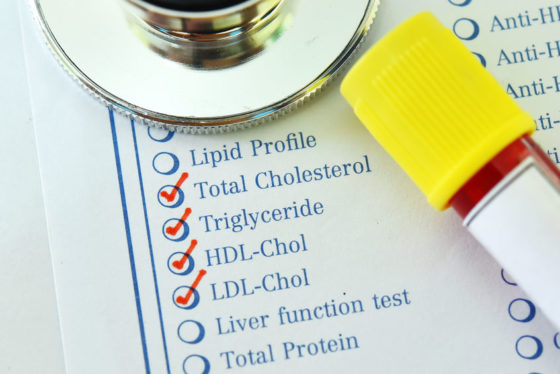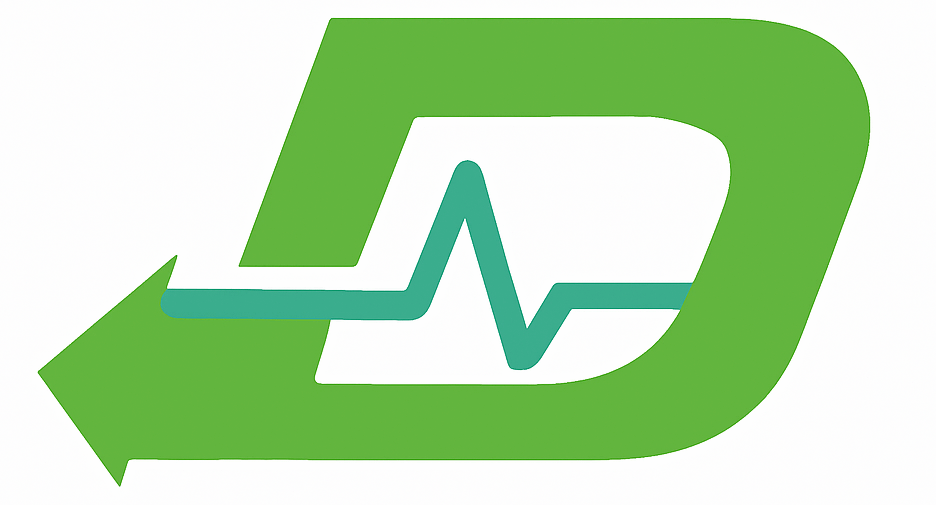Estimated reading time: 5 minutes
Non-HDL cholesterol (non-HDL-C) is a fraction that can be easily calculated from a traditional lipid panel. The value is strongly associated with an increased risk of heart disease.
Over the years, LDL cholesterol (LDL-C) has been the most commonly used lipid variable to predict risk (1). However, current evidence suggests that non-HDL cholesterol may be a better tool for risk assessment (2).

To calculate non-HDL cholesterol, you only need to know the numbers for total cholesterol and HDL cholesterol (HDL-C).
But, what makes non-HDL cholesterol such a useful measure of future risk?
The Role of Lipoproteins
Cholesterol and most other lipids are insoluble in blood. They are made soluble by attachment to specifically designed proteins. These particles are called lipoproteins.
Lipoproteins are responsible for transporting important lipids, such as cholesterol and triglycerides, to various body tissues.
Despite the critical role of lipoproteins, some seem to play a role in the formation of atherosclerosis and may promote heart disease.
Lipoproteins that are directly involved in atherosclerosis are termed atherogenic. Atherogenic lipoproteins tend to promote the formation of fatty deposits in the arteries.
There are five major lipoproteins in blood:
- Chylomicrons
- Very low-density lipoprotein (VLDL)
- Intermediate-density lipoprotein (IDL)
- Low density lipoprotein (LDL)
- High density lipoprotein (HDL)
The Standard Lipid Profile
Screening patients for the risk of heart disease involves the measurement of blood lipids. Usually, this is accomplished by obtaining a lipid profile.
A standard lipid profile measures total cholesterol, triglycerides, and HDL cholesterol. LDL cholesterol is estimated by calculation using a specifically designed formula called the Friedewald equation(3).
It is crucial to understand that these numbers don’t reflect the number of lipoprotein particles. They only tell us how much lipid mass is carried by the different types of lipoproteins.
For historical reasons, LDL cholesterol has become a primary goal for the prevention of heart disease. Hence, recommendations regarding diet and drug therapy are usually aimed at lowering LDL cholesterol (4).
However, LDL is not the only lipoprotein involved in atherosclerosis and heart disease.
Furthermore, using LDL cholesterol to assess risk has several pitfalls (5).
Therefore, there is a need for a lipid parameter that better reflects the amount of cholesterol within all atherogenic particles. This is of particular importance when triglyceride levels are high, which is quite common, for example among people with abdominal obesity or metabolic syndrome.
The Advantage of Non-HDL Cholesterol
Both HDL and LDL lipoproteins are essential carriers of cholesterol in the blood stream. However, when it comes to atherosclerosis, they seem to play a very different role. Therefore, measuring the amount of cholesterol within these particles tells two different stories.
While high levels of LDL cholesterol are associated with an increased risk of heart disease, elevated levels of HDL cholesterol are associated with lower risk.
HDL lipoprotein particles appear to be involved in clearing and removing cholesterol from arteries and atherosclerotic plaques, while LDL particles seem to participate directly in atherosclerosis formation.
Therefore, cholesterol carried by HDL particles is often called “good cholesterol” and cholesterol carried by LDL particles is called “bad cholesterol.” Of course, it is the same cholesterol; the difference lies within the lipoproteins that carry it.
Measuring total cholesterol provides limited information about risk because it includes both HDL – and LDL cholesterol.
However, if we subtract HDL cholesterol from the total cholesterol, we will have a measure of the amount of cholesterol carried by all lipoproteins except HDL.
Doing this simple math will give us the amount of cholesterol carried withinall atherogenic lipoproteins. In other words, a measure of cholesterol carried by all the “bad” lipoproteins but not the “good” ones (which is only HDL). This fraction is termed non-HDL cholesterol (non-HDL-C).
Relying on LDL cholesterol alone may be misleading.
For example, individuals with abdominal obesity, metabolic syndrome or diabetes often have elevated triglycerides, low HDL cholesterol, and relatively normal calculated LDL cholesterol.
Despite their normal LDL cholesterol, these patients produce highly atherogenic lipoproteins such as VLDL and IDL.
Non-HDL cholesterol appears to be a better marker of risk than LDL cholesterol in both primary and secondary prevention studies(6).
In an analysis of data combined from 68 studies, non-HDL cholesterol was the best risk predictor of heart disease of all cholesterol measures (7).
Another advantage of using non-HDL cholesterol is that you don’t need a fasting blood sample.
How to Calculate Non-HDL Cholesterol
Non-HDL cholesterol is total cholesterol minus HDL cholesterol.
This is the formula:
Non-HDL Cholesterol = Total Cholesterol – HDL cholesterol
So, if your total cholesterol is 220 mg/dL (5.7 mmol/L) and your HDL cholesterol is 50 mg/dL (1.3 mmol/L), non-HDL Cholesterol is 170 mg/dL (4.4 mmol/L).
What Is a Desirable Level of Non-HDL Cholesterol?
The treatment goal for non-HDL cholesterol is usually 30 mg/dL (0.8 mmol/L) above the LDL cholesterol treatment target.
For example, if the LDL-C treatment goal is <70 mg/dL (1.8 mmol/L), the non-HDL cholesterol treatment target would be <100 mg/dL (2.6 mmol/l).
Here you can see how non-HDL-C levels are looked at in terms of risk:
- above 220 mg/dL (5.7 mmol/L) is considered very high
- 190 – 219 mg/dL (4.9 – 5.6 mmol/L) is considered high
- 160– 189 mg/dL (4.1 – 4.8 mmol/L) is considered borderline high
- 130 – 159 mg/dL (3.4 – 4.0 mmol/L) is considered near ideal
- below 130 mg/dL (below 3.4 mmol/L) is considered ideal for people at risk of heart disease
- below 100 mg/dL (below 2.6 mmol/L) is considered ideal for people at very high risk of heart disease
How To Lower Non-HDL Cholesterol
Lowering non-HDL cholesterol always begins with lifestyle therapy, usually aimed at lowering triglycerides.
Traditionally, a reduction in total calories, especially saturated and trans fatty acids, is recommended in combination with exercise.
Reducing sugar and carbohydrate consumption can also be very useful in lowering triglycerides and non-HDL cholesterol, particularly in individuals with abdominal obesity or metabolic syndrome (7).
Foods that are high in omega-3 fatty acids may also be useful. Fatty fish such as salmon, sardines, mackerel, and herring are rich in omega-3.
Moderate physical activity can help raise HDL cholesterol and lower non-HDL cholesterol (8).
Quitting smoking will improve HDL cholesterol and reduce non-HDL-cholesterol.
Successful reduction of elevated non-HDL cholesterol may also be achieved with medical therapy.
Statin drugs lower total and LDL cholesterol leading to a reduction in non-HDL cholseterol.
Triglyceride lowering drugs such as omega-3 fatty acid preparations, fibrates, and niacin are sometimes used as well.
Discover more from Doc's Opinion
Subscribe to get the latest posts sent to your email.

I deeply appreciate these opinions/education!
Thank you very much—-
What does a non-HDL-C level of 95 mean for someone who has not ever been considered a high risk for heart disease? Is this then a good level, if not excellent ? Or is it possibly too low a number? It’s a little confusing to me this risk-rating.
Hi Barney
That’s an ideal number and doesn’t put you at increased risk.
I rarely saw a patient above 40yo with levels below 130 mg/dL during my practice. Not saying never met.. just rarely.
My LDL is 2.7 and HDL 2.68. Total cholesterol is 5.7. My cardiologist said that an LDL of 2.7 is way too high and I need to get it down to 1.5. Any advice? I am 69, normal weight, active and vegetarian.
Hi Marge
LDL-C 2.7 is great unless you have an established cardiovascular disorder. In that case your target should be less than 1.8 which is proably only achievable with drug treatment in your case.
My non hdl is 160
HDL is 78
LDL is 139
Total 238 I’m 64 yo
What is my target do I need meds?
So confusing?
Tyvm in advance fir your expertise,
Btw,
Weight and height normal
triglycerides better than Ave ratio
Been watching my diet cholesterol since 4/2018
History of Xanthelasma in 2019 that’s how I learn about cholesterol urgh
My serum cholesterol is 6.9
HDL is 1.1
Non hdl cholesterol is 5.8
Cholesterol/hdl ratio is 6.3
Hi
My non dhl-c is 3
LDL is 2.67 and HDL is 1.86
Triglycerides 0.81
Cholesterol 2.6
I am 55
Should I be worried?
LDL-C 2.67 is great unless you have an established cardiovascular disorder. In that case your target should be less than 1.8 which is proably only achievable with drug treatment in your case.
Cholesterol level 7.4
Serum non high density lipoprotein cholesterol level 5.3 mmol/L
Triglyceride levels 1.7
Serum LDL cholesterol level 4.5
HDL cholesterol level 2.1
Cholesterol/HDL ratio 3.5
Weight 59kg Age 52
Am I at risk ?
Could I please have some help? I have had some conflicting information about my cholesterol level and I’m worried about it.
My numbers are:
Non HDL (bad) 4.4mmol
HDL (good) 2.2mmol
Total 6.6mmol
The GP told me that it was a bit high but he would be worried if it was above 7/8. He also said my ratio of HDL to non was really good at 3.
However, the nurse I saw today said it was really high and said I should consider a statin.
What are your thoughts?
I need help!! My overall cholesterol is 250, HDL is 40, triglycerides are 106, VLDL is 19, LDL is 190, & cholesterol/HDL ratio is 6.3. No heart disease or diabetes in family, AIC is 5.5, Glucose is 90. Have lost 80 pounds past year on low carb, high fat diet. HOMA – IR test 1.4 down from 3.5. Only getting carbs from fruits/veggies, nothing processed, no sugar, no junk. Doc follows protocol, & wants me to take meds. I’m 66 & am a bit resistive to taking them. Please advise.